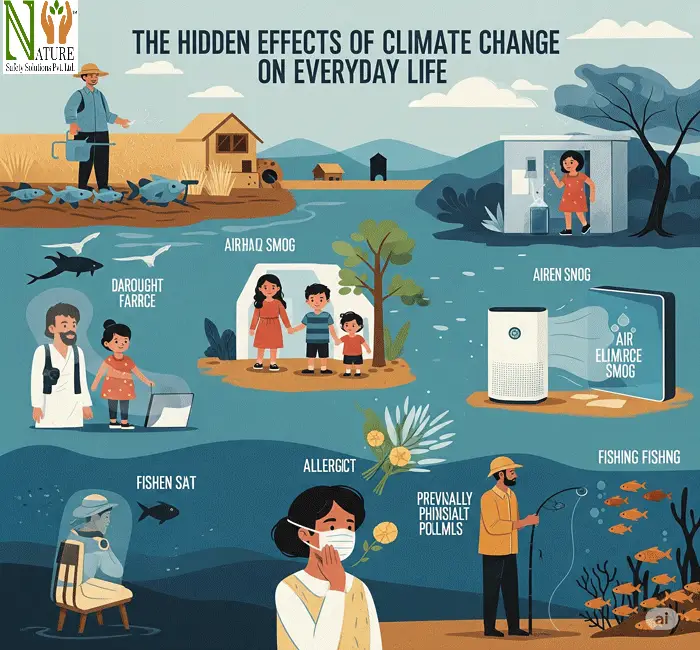Climate change is often discussed in terms of rising temperatures, extreme weather events, and melting ice caps. However, its effects go far beyond these visible signs, subtly influencing various aspects of our daily lives. From the food we eat to the air we breathe, climate change is reshaping our world in ways we may not immediately recognize.

1. Food and Agriculture
One of the most significant yet overlooked impacts of climate change is on food production. Changes in temperature, rainfall patterns, and the frequency of extreme weather events affect crop yields, leading to food shortages and price fluctuations.
Reduced Crop Yields: Heatwaves and droughts reduce the productivity of staple crops like wheat, rice, and corn.
Changing Nutritional Value: Studies suggest that rising CO₂ levels can lower the nutritional quality of crops, reducing essential nutrients like protein, iron, and zinc.
Impact on Fisheries: Ocean warming and acidification disrupt marine ecosystems, affecting fish populations and seafood availability.
2. Health and Well-Being
Climate change has direct and indirect effects on human health, influencing disease patterns, air quality, and mental health.
Increase in Respiratory Issues: Rising temperatures contribute to higher levels of air pollution, worsening conditions like asthma and bronchitis.
Spread of Infectious Diseases: Warmer climates allow disease-carrying insects, such as mosquitoes, to expand their range, increasing the spread of malaria, dengue, and Lyme disease.
Mental Health Struggles: Natural disasters, displacement, and environmental anxiety contribute to stress, depression, and post-traumatic stress disorder (PTSD).
3. Water Supply and Quality
Climate change affects both the availability and quality of water resources, leading to shortages and contamination.
Droughts and Water Scarcity: Prolonged droughts reduce freshwater supplies, affecting drinking water and agriculture.
Flooding and Contamination: Heavy rainfall and flooding can overwhelm sewage systems, leading to waterborne diseases.
Glacial Melt and Rising Sea Levels: Melting glaciers threaten freshwater sources, while rising sea levels increase saltwater intrusion into coastal water supplies.
4. Infrastructure and Daily Commutes
Extreme weather events and shifting climate patterns impact transportation, housing, and urban infrastructure.
Damage to Roads and Bridges: Heatwaves cause asphalt to soften, while flooding erodes foundations, leading to costly repairs.
Disruptions in Public Transport: Storms, wildfires, and extreme temperatures can delay or halt train and bus services.
Higher Energy Costs: Increased demand for air conditioning during heatwaves and heating during cold spells raises electricity consumption and costs.
5. Consumer Goods and Economy
Climate change affects global supply chains, leading to shortages and price increases for everyday products.
Disruptions in Manufacturing: Extreme weather events damage factories and disrupt production.
Higher Prices for Goods: Crop failures and resource shortages drive up the cost of food, clothing, and electronics.
Insurance and Property Costs: More frequent natural disasters lead to higher insurance premiums and property damage expenses.
6. Biodiversity and Local Ecosystems
Changes in climate alter ecosystems, affecting wildlife and plant life in ways that impact human activities.
Loss of Pollinators: Declining bee populations due to habitat loss and temperature changes threaten food production.
Shifts in Plant Growth: Warmer temperatures affect flowering seasons, disrupting agriculture and gardening.
Invasive Species: Changing climates allow non-native species to thrive, outcompeting local flora and fauna.
Also read:-
- Stay Safe at Work: 10 Daily Manufacturing Safety Tips
- Water Conservation Tips for Offices and Factories
- Top 10 Reasons to Upgrade to EHS Safety Audit Tools
- Why Environment, Health & Safety Matters More Than Ever
- The Role of EHS Professionals in a Post-Pandemic World
- Benefits of Tree Plantation Drives at Workplaces
